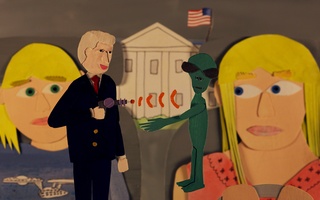{shortcode-3f3edd5c19763e69f8693e2ec8c2941097a419e3}
Marlom Meirelles entered the film industry far from the star-studded sidewalks of Los Angeles. The 26-year-old director-producer hails from Bezerros, a small town in the northeastern countryside of Pernambuco, Brazil. At just 21 years old, he founded his own production company, Eixo Audiovisual. Meirelles has since gone on to present his short film “A Emparedada de Rua Nova” (The Bricked Girl) at the Cannes Film Festival and win a script competition for his documentary “Entre Mulheres” (Among Women), which deals with women’s rights and gender issues. On Oct. 13, Meirelles visited Harvard’s David Rockefeller Center for Latin American Studies for a screening and discussion of his latest film, “Olhos de Botão” (Button Eyes). Meirelles spoke with The Crimson during his visit to campus in anticipation of the presentation of this 18-minute fictional suspense short film.
The Harvard Crimson: What drew you to filmmaking at such a young age?
Marlom Meirelles: I feel very comfortable having a camera in my hands because since I was very young, I was always filming. I’m from the VHS generation, so I was always making films at family events and in schools. Then, it became an obsession. And then I went to college to study film, and it became something professional and a part of my life.
THC: How would you describe your style of filmmaking?
MM: I’m a young filmmaker—I’m only 26 years old—so I’m still getting to know my style. I like to bring in references from Brazilian filmmakers and also references from South American filmmakers and filmmakers from America and Europe and Asia…. As for my style, this is the second film I’ve done using legends from [the Pernambuco countryside] as a theme. I like to use fantastic elements in my film, [though] I try to keep it realistic because I also work on documentaries.
THC: What are your thoughts on the current status of filmmaking in Brazil?
MM: Luckily we are living in a very good moment right now. If we look back in history, in the ’80s, the Brazilian government stopped funding films and culture in general, and it was a very tough time. And then we had to recover, and it took a lot of years. But now the government is investing a lot of money in filmmaking, so they have a fund…. So it’s like a big cake, and everyone is taking a slice to produce the films. I feel very privileged to be in this era right now, so I can be part of it.
THC: What specifically can you tell us “Olhos de Botão”?
MM: I was very inspired by the folk legends that are very common in my state and also all the states in that region of Brazil…. But also I took inspiration from negative aspects of the Brazilian culture, because we live in a very traditional, conservative society. When people watch the Brazilian Carnival, they have a picture of Brazil that is not really reality…. This [clash] is an aspect of our culture [that] I tried to make clear through this film.
THC: Why did you decide to participate in the DRCLAS screening at Harvard?
MM: Well this is the kind of invitation that you cannot refuse. I had to devote more time in my life as a filmmaker producing films rather than being in an academic space. So every time I get an opportunity like this one to talk to people from the academic side, I think it gives me a different perspective about the film, especially with critics, who watch a lot of films.
THC: Why do you think you have achieved such impressive success for your age?
MM: I think it takes a lot of persistence. It’s very important to be focused and also to know yourself as an artist…. When you know what you are trying to communicate to people, I think it helps you to get to a more international level and to communicate with other audiences from all around the world. For example, [“Olhos de Botão”] was recorded in a very specific area in the northeast of the Brazilian countryside. But people from Russia or from Israel can watch the film and understand that context, because the interaction between the characters is more universal.
THC: Do you think people in Brazil will react to the content of the film differently from your international audiences?
MM: The nicest thing about my film is that it’s up to interpretation. When it’s finished, you don’t really get a finished feeling; you don’t feel that it’s done. It keeps going on in your mind, so it’s open to interpretation…. And that’s how film works: You take away something from the film, based on what you bring to it.Read more in Arts
Improv Groups Bring Laughs and Camraderie with 'VERI(funny)TAS'Recommended Articles
-
From Cannes: "Hitchcock/Truffaut" IlluminatesIn our continuing Cannes coverage, Tianxing Lan discusses Ken Jones's documentary "Hitchcock/Truffaut," which examines the historic interview in which the two great directors met.
-
 Artist Spotlight: Leo B. Birenberg
Artist Spotlight: Leo B. Birenberg -
 In Focus: Jean-Michel Frodon
In Focus: Jean-Michel Frodon -
Portrait of an Artist: Lisandro AlonsoLisandro Alonso is an Argentine filmmaker who first gained international recognition in 2001 with his debut film “La Libertad,” and whose last work, “Jauja,” won the FIPRESCI Prize at the 2014 Cannes film festival. He is currently a research fellow at the Radcliffe Institute for Advanced Study. The Crimson sat down with Alonso to discuss his thought-provoking body of work.
-
 Portrait of an Artist: Clyde Petersen
Portrait of an Artist: Clyde Petersen













